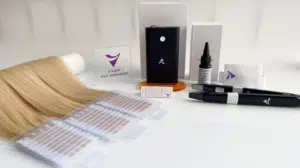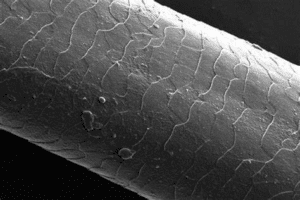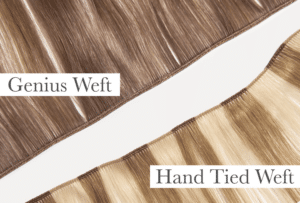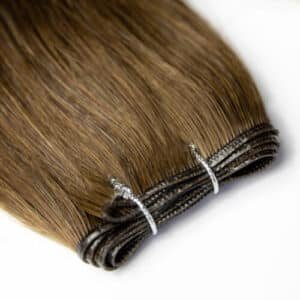Worried about ruining your clip-ins by stepping into the shower? You’re not alone—many stylists and clients make this mistake.
You should never shower with clip-in hair extensions. Water weakens their grip, damages the clips, and shortens the hair’s lifespan—especially if they’re full cuticle human hair.
Still wondering what happens if you do? Let’s break it down from multiple angles and give you a clear care routine to share with your clients.
Is It Okay to Shower With Clip-In Extensions?
Thinking a quick rinse won’t hurt?
It’s not okay to shower with clip-in extensions. Water and steam cause slippage, rust, and damage to both the wefts and natural hair.

Clip-ins are temporary extensions designed for daytime wear. They use small metal clips to attach to natural hair, which aren’t waterproof. Showering introduces moisture to both the metal and the stitched base, causing:
- Clip corrosion or rust
- Weft loosening or tangling
- Shorter product lifespan
- Risk of slipping off mid-shower
If clip-ins are made from full cuticle hair, exposure to hot water and steam can dry out the strands or strip protective oils. Stylists should instruct clients to always remove clip-ins before showering, bathing, or any high-moisture activity.
What Happens to Clip-In Extensions If They Get Wet?
Forgot to remove them before hopping in?
If clip-ins get wet, they may lose their shape, shed, frizz, or slip—especially if synthetic. Human hair wefts also risk damage if not dried and detangled quickly.
Let’s break it into scenarios:
Human Hair Clip-Ins
- Mild Damage: If washed once with mild shampoo and dried properly.
- Severe Damage: If repeatedly exposed to moisture, or dried with high heat.
Synthetic Clip-Ins
- Permanent Damage: Synthetic fibers don’t tolerate water. The hair loses texture, tangles easily, and becomes unwearable.
Damage affects not only the hair quality but also your brand perception if you’re selling or installing. Prevention is key.
Can You Use Shampoo and Conditioner on Clip-Ins?
Need to freshen up your extensions?
Yes—but only after removal. Clip-in extensions should be washed separately using sulfate-free shampoo and moisture-rich conditioner.
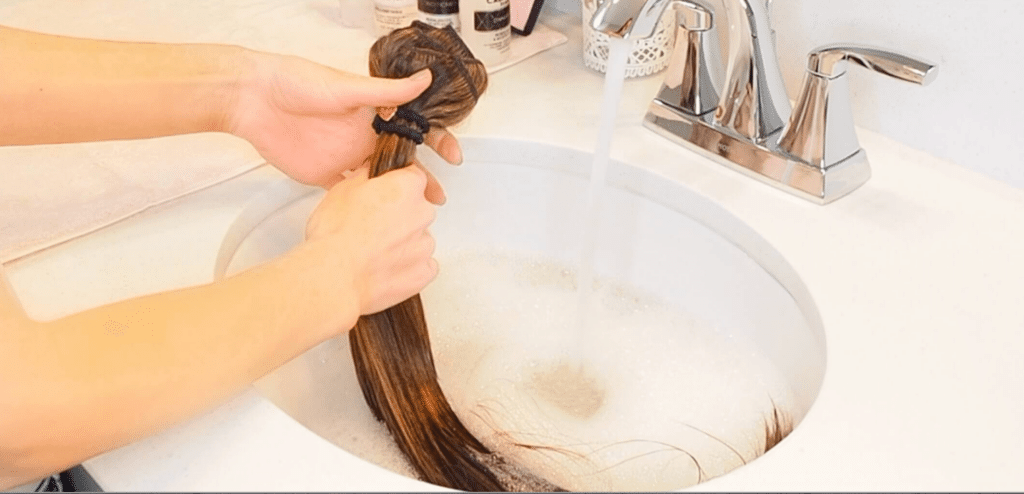
Here’s how to safely clean clip-ins:
When to Wash:
- Every 15–20 wears
- When there’s noticeable product buildup
- After styling with heavy sprays or oils
How to Wash:
- Detach all wefts and gently brush out tangles.
- Soak in cool water with sulfate-free shampoo.
- Rinse, then apply conditioner mid-shaft to ends.
- Rinse again. Pat dry with a towel.
- Lay flat to air dry on a clean towel.
Never soak the clips in water or use hot tools on wet hair. Conditioning sprays or oils should never touch the metal clips.
What Should You Do If You Shower With Clip-Ins by Accident?
Accidentally got them wet in the shower?
If your clip-ins got wet, remove them, rinse with clean water, apply a deep conditioner, and air dry them flat to prevent matting and rust.
You can’t undo water exposure—but you can limit the damage:
Post-Shower Clip-In Rescue:
- Step 1: Remove immediately and detangle using a loop brush
- Step 2: Rinse thoroughly with cold, clean water
- Step 3: Apply deep conditioning mask for 30 minutes
- Step 4: Avoid combing while wet. Let air dry completely
- Step 5: Inspect clips for rust or damage. Replace if needed
If the extensions are beyond repair, it’s a lesson in aftercare. Consider adding a “care card” for your salon or online orders to educate buyers.

Are Synthetic Clip-Ins Safe for Showers?
Trying to save money with synthetic clip-ins?
Synthetic extensions should never be worn in the shower. Water deforms synthetic fibers permanently, causing frizz, texture loss, and tangling.
Synthetic hair reacts very differently than human hair. The fibers are plastic-based and not water-absorbent. When wet, they become stiff or overly limp, then dry in unpredictable shapes. Some effects include:
- Uncontrollable frizz
- Unnatural shine or dull finish
- Tangled clumps
- Unfixable texture
Most synthetic clip-ins also melt under heat tools, so you can’t restyle them after damage. If your client insists on synthetic hair, make sure they know showering is completely off-limits.

Do Clip-Ins Grow Mold or Smell If Left Wet?
Worried about mold or odor?
Yes—clip-ins can smell bad or even grow mold if stored while damp or wet.
Mold forms when moisture is trapped and not dried properly. With clip-in extensions, the risk increases due to:
- Thick bundles retaining moisture inside
- Metal clips holding water at the seam
- Lack of ventilation in storage pouches or drawers
Prevent this by:
- Always drying extensions 100% before storing
- Using a satin or mesh pouch
- Avoiding enclosed containers like plastic boxes if the hair isn’t fully dry
If extensions smell musty or show dark patches near the clip, discard them. It’s unsanitary and risky to wear mold-exposed products.
What Hair Extensions Can You Shower With?
Need a water-friendly extension alternative?
Keratin tip, tape-in, or hand-tied wefts can tolerate occasional water exposure when properly installed and maintained.
Here’s a comparison of different extension types:
| Extension Type | Shower Safe? | Notes |
|---|---|---|
| Clip-Ins | ❌ | Always remove before water |
| Tape-Ins | ✅ (with care) | Use sulfate-free shampoo and dry roots |
| Keratin U Tip | ✅ | Long-lasting, bonded to hair |
| Hand-Tied Weft | ✅ | Durable with proper drying |
| Halo Extensions | ❌ | Not secure in water |
If your client insists on daily hair-washing, suggest a semi-permanent method with full cuticle hair. Educate them about drying roots thoroughly to avoid mold or mildew near the scalp.
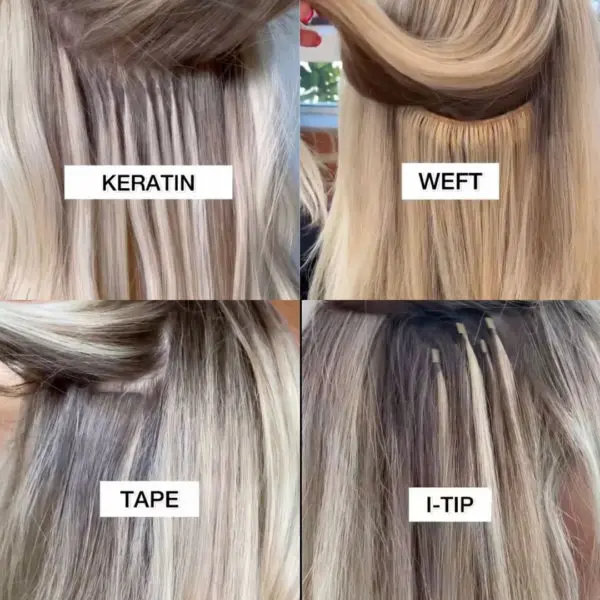
My Opinion
As a manufacturer, I strongly advise that clip-ins are not meant for showers. I’ve seen clients destroy beautiful full cuticle hair by washing them while attached. Clip-ins are for style—not for steam, water, or wet environments. Protect your investment. Educate your clients. And always provide proper aftercare instructions.
FAQ
Q: Can I wear clip-ins in the shower if I use a cap?
A: No. Most shower caps aren’t fully waterproof around the hairline.
Q: What if I sweat with clip-ins on?
A: Sweat is okay, but clean and air them afterward if they get damp.
Q: Should I dry clip-ins with a hair dryer?
A: Air dry is best. If needed, use a blow dryer on cool only.
Q: Can clip-ins be worn in a sauna or steam room?
A: No. Steam causes frizz, warping, and clip rust.
Q: Can clip-ins go moldy?
A: Yes—if stored while wet or damp, especially in humid conditions.
Q: How should I store clip-in extensions?
A: In a cool, dry place—fully dry, brushed, and laid flat.
Q: Can I wash my clip-ins every week?
A: Only if they’ve been heavily used or styled. Otherwise, every 15–20 wears is enough.
Q: Can I use leave-in conditioner in the shower with clip-ins?
A: Only after removing them. Keep product away from clip base.
Conclusion
Never shower with clip-in extensions. Remove them, wash separately, and care properly to protect their quality and lifespan.

